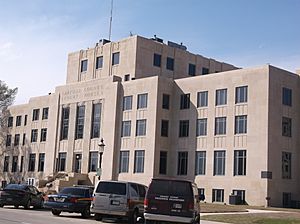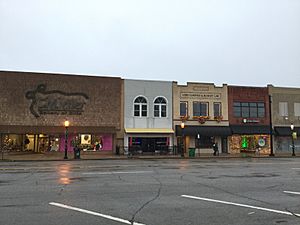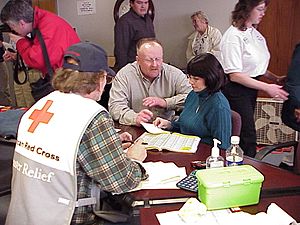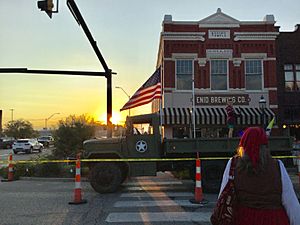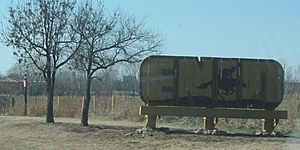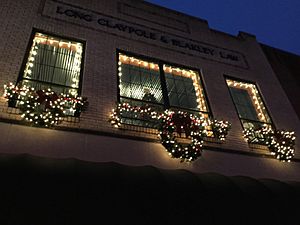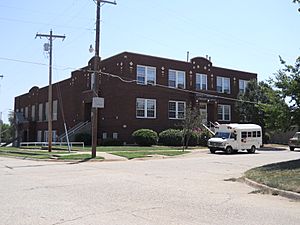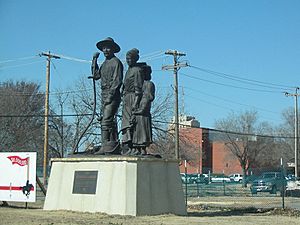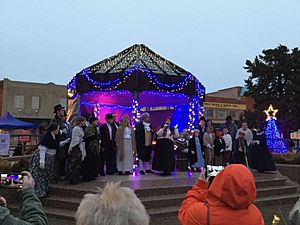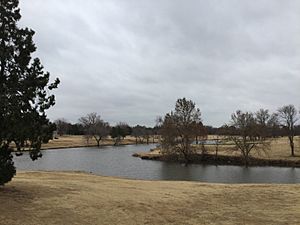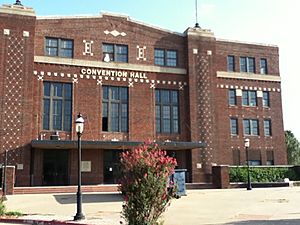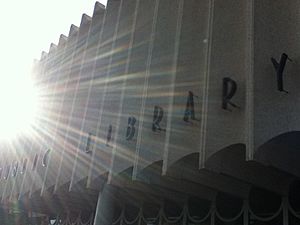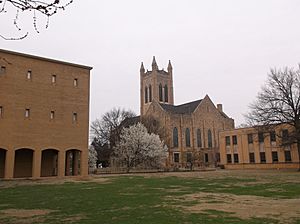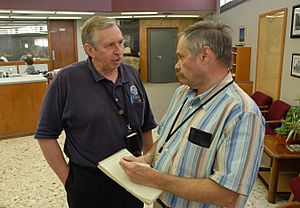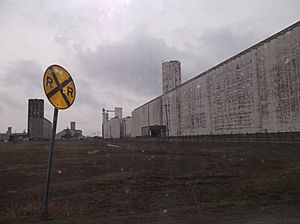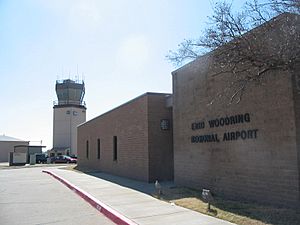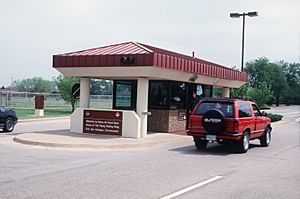Enid, Oklahoma facts for kids
Quick facts for kids
Enid, Oklahoma
|
|||
|---|---|---|---|
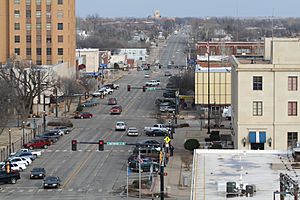
Downtown Enid (2007)
|
|||
|
|||
| Nicknames:
"Wheat Capital of the United States", "Queen Wheat City of Oklahoma",
|
|||
| Motto(s):
"Purple Martin Capital of Oklahoma"
|
|||

Location in Garfield County and the state of Oklahoma.
|
|||
| Country | United States | ||
| State | Oklahoma | ||
| County | Garfield | ||
| Founded | 1893 | ||
| Government | |||
| • Type | Council-Manager | ||
| Area | |||
| • City | 74.02 sq mi (191.71 km2) | ||
| • Land | 73.94 sq mi (191.49 km2) | ||
| • Water | 0.08 sq mi (0.21 km2) | ||
| Elevation | 1,250 ft (380 m) | ||
| Population
(2020)
|
|||
| • City | 51,308 | ||
| • Density | 693.95/sq mi (267.94/km2) | ||
| • Metro | 62,846 (US: 384th) | ||
| Time zone | UTC−6 (CST) | ||
| • Summer (DST) | UTC−5 (CDT) | ||
| ZIP Codes |
73701, 73703
|
||
| Area code(s) | 580 | ||
| FIPS code | 40-23950 | ||
| GNIS feature ID | 2410442 | ||
Enid is a city in Oklahoma, one of the largest in the state. It is the main city of Garfield County. In 2020, about 51,308 people lived there.
Enid was started during the Land Run of 1893, when new land was opened. It's named after a character from a poem by Alfred, Lord Tennyson. Oklahoma officially called Enid the "purple martin capital" in 1991. Enid is also known as the "Wheat Capital" because it can store a lot of grain. It has the third-largest grain storage in the world!
Contents
History of Enid
Before Enid was founded, the land was part of the Cherokee Outlet. It was used by the Cherokee people. Important paths like the Chisholm Trail and railroads went through the area. The town was first called Skeleton.
In 1889, a railroad official named M.A. Low visited. He didn't like the name Skeleton. So, he renamed the station Enid, after a character from a poem. A fun story says settlers once hung a "DINE" sign, and others turned it backward to read "ENID." The name stuck!
During the Land Run of 1893, Enid was a place where people could claim land. The original government-approved town site was called Enid (now North Enid, Oklahoma). However, the government later moved the official land office south. This caused a conflict known as the Enid-Pond Creek Railroad War.
People jumped from trains to claim land at the new site, called South Enid. By the end of the land run, Enid's population was around 12,000. A year later, it was about 4,410. By 1907, when Oklahoma became a state, it grew to 10,087.
[[Stack |
| float=right]]
The early days of Enid were written about by author Marquis James in his book Cherokee Strip. He described Enid as a wonderful place with many buildings and people.
Enid had a "golden age" after oil was found in the 1910s. The city's economy grew with oil, wheat, and railroads. Many new buildings were constructed, like the Broadway Tower and the Garfield County Courthouse. Large grain companies also built huge grain elevators. This helped Enid earn its nicknames, "Wheat Capital of Oklahoma" and "Wheat Capital of the United States."
Geography and Climate

Enid is in Northwestern Oklahoma, at the edge of the Great Plains. It is about 70 miles (110 km) north of Oklahoma City.
The city covers about 74.1 square miles (192 km2). Most of this is land, with a small amount of water.
Weather in Enid
Enid has hot summers and cold, often snowy winters. Spring brings thunderstorms, which can sometimes cause tornadoes. In 1973, Enid had a record rainfall of 15.68 inches (398 mm) in one day.
Temperatures can drop below 0°F (–18°C) in winter and go above 100°F (38°C) in summer. The hottest temperature ever recorded was 118°F (48°C) in 1936. The coldest was –20°F (–29°C) in 1905. July is usually the warmest month, and January is the coolest. June typically has the most rain.
| Climate data for Enid, Oklahoma (1991–2020 normals, extremes 1894–present) | |||||||||||||
|---|---|---|---|---|---|---|---|---|---|---|---|---|---|
| Month | Jan | Feb | Mar | Apr | May | Jun | Jul | Aug | Sep | Oct | Nov | Dec | Year |
| Record high °F (°C) | 84 (29) |
92 (33) |
100 (38) |
101 (38) |
104 (40) |
111 (44) |
115 (46) |
118 (48) |
109 (43) |
100 (38) |
92 (33) |
85 (29) |
118 (48) |
| Mean daily maximum °F (°C) | 46.7 (8.2) |
51.4 (10.8) |
61.0 (16.1) |
70.1 (21.2) |
79.4 (26.3) |
89.3 (31.8) |
94.8 (34.9) |
93.2 (34.0) |
85.2 (29.6) |
72.9 (22.7) |
59.1 (15.1) |
48.3 (9.1) |
71.0 (21.7) |
| Daily mean °F (°C) | 35.7 (2.1) |
39.8 (4.3) |
49.0 (9.4) |
58.0 (14.4) |
68.5 (20.3) |
78.2 (25.7) |
83.3 (28.5) |
81.6 (27.6) |
73.5 (23.1) |
60.8 (16.0) |
48.1 (8.9) |
38.0 (3.3) |
59.5 (15.3) |
| Mean daily minimum °F (°C) | 24.7 (−4.1) |
28.1 (−2.2) |
37.0 (2.8) |
45.9 (7.7) |
57.5 (14.2) |
67.1 (19.5) |
71.8 (22.1) |
70.0 (21.1) |
61.7 (16.5) |
48.8 (9.3) |
37.1 (2.8) |
27.8 (−2.3) |
48.1 (8.9) |
| Record low °F (°C) | −14 (−26) |
−20 (−29) |
0 (−18) |
18 (−8) |
28 (−2) |
43 (6) |
50 (10) |
45 (7) |
33 (1) |
17 (−8) |
9 (−13) |
−10 (−23) |
−20 (−29) |
| Average precipitation inches (mm) | 1.04 (26) |
1.28 (33) |
2.41 (61) |
3.42 (87) |
4.36 (111) |
4.83 (123) |
3.34 (85) |
3.63 (92) |
2.73 (69) |
3.06 (78) |
1.69 (43) |
1.50 (38) |
33.29 (846) |
| Average snowfall inches (cm) | 2.4 (6.1) |
2.0 (5.1) |
1.5 (3.8) |
0.0 (0.0) |
0.0 (0.0) |
0.0 (0.0) |
0.0 (0.0) |
0.0 (0.0) |
0.0 (0.0) |
0.0 (0.0) |
0.4 (1.0) |
3.1 (7.9) |
9.4 (24) |
| Average precipitation days (≥ 0.01 in) | 5.2 | 5.6 | 7.1 | 7.8 | 9.6 | 8.7 | 6.7 | 7.5 | 6.6 | 6.4 | 5.4 | 5.7 | 82.3 |
| Average snowy days (≥ 0.1 in) | 2.1 | 1.8 | 0.9 | 0.1 | 0.0 | 0.0 | 0.0 | 0.0 | 0.0 | 0.0 | 0.3 | 1.8 | 7.0 |
| Source: NOAA | |||||||||||||
In January 2002, a big ice storm hit Enid. It caused over $100 million in damage. Many homes and businesses lost power for days. The American Red Cross helped by setting up shelters.
Other notable storms in Enid's history include:
- March 16, 1965: An F4 tornado caused injuries and damage.
- October 11–13, 1973: The "Enid flood" brought over 15 inches (380 mm) of rain. Nine people died, and residents had to cut holes in roofs to escape.
- May 2, 1979: Another F4 tornado killed one person and injured 25.
- April 25, 2009: An EF-2 tornado damaged the Chisholm Trail Expo Center.
People and Culture
| Historical population | |||
|---|---|---|---|
| Census | Pop. | %± | |
| 1900 | 3,444 | — | |
| 1910 | 13,799 | 300.7% | |
| 1920 | 16,576 | 20.1% | |
| 1930 | 26,399 | 59.3% | |
| 1940 | 28,081 | 6.4% | |
| 1950 | 36,071 | 28.5% | |
| 1960 | 38,859 | 7.7% | |
| 1970 | 44,986 | 15.8% | |
| 1980 | 50,363 | 12.0% | |
| 1990 | 45,417 | −9.8% | |
| 2000 | 47,045 | 3.6% | |
| 2010 | 49,379 | 5.0% | |
| 2020 | 51,308 | 3.9% | |
As of 2020, Enid had 51,308 residents living in 19,428 homes. About 25.2% of the population were children under 18. About 49.4% of residents are female.
Religious Life
Many people in Enid belong to a religious group. There are many Christian churches, including Catholic and Protestant. Enid has several historically Black churches and churches serving its Korean and Hispanic communities.
Enid also has a small Bahá’í group. Historically, Enid had a small Jewish community. The Enid Cemetery has a Jewish section.
Marshallese Community
Enid has one of the largest Marshallese populations in the United States. Many Marshallese moved to Enid because of nuclear testing at Bikini Atoll in their home islands. Missionaries from Phillips University first brought Marshallese students to Enid. Others came to work at food plants and stores.
In 2022, about 2,800 Marshallese lived in Enid. The Enid Public Schools district helps Marshallese students learn English. They also have special helpers for the Marshallese community.
African-American Community
The local chapter of the NAACP was started in 1941. It worked for civil rights in Enid. The city has named streets after famous Black citizens like opera singer Leona Mitchell. In 1990, Enid named its city building after Dr. Martin Luther King, Jr. An annual march honors him.
Economy and Jobs
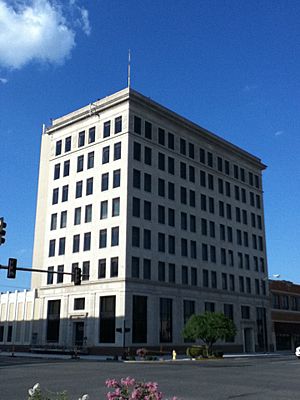
Enid's economy has always been strong in wheat and oil. A city song from the 1920s mentioned its "best wheat" and "oil that flows." The city boomed in the early 1900s.
However, the Great Depression caused many businesses to close. Enid recovered, but faced challenges again in the 1980s. Since 1994, Enid's Main Street program has worked to improve downtown. They fix up old buildings and host local events.
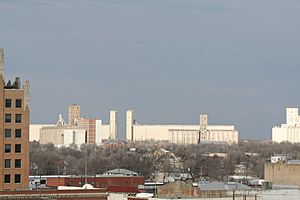
Companies with headquarters in Enid:
- AdvancePierre Foods (makes prepared food)
- Atwood Distributing, LP (sells farming and pet supplies)
- Johnston Enterprises Inc. (handles grain)
- Pumpstar (makes concrete pumping machines)
- Groendyke Transport (transports liquids in tanks)
Companies with operations in Enid:
- The Koch Industries plant makes a lot of fertilizer.
- Arctic Slope Regional Corporation helps run Vance Air Force Base.
- Vertex provides aircraft maintenance at Vance Air Force Base.
Historical companies in Enid:
- Champlin Oil: This company grew to have gas stations in 20 states.
- Geronimo Motor Company.
Water Supply Project
In 2020, Enid started a huge project to get water from Kaw Lake. They are building a 70-mile (110 km) pipeline. This pipeline will bring 10 million gallons of water a day to Enid. It is expected to supply water for the next 40–50 years. This is the city's most expensive project ever. Construction began in 2021.
Arts and Fun
Enid hosts the annual Tri-State Music Festival every spring. It started in 1932.
The Gaslight Theatre performs Shakespeare in the Park in summer. They also have plays all year. The Enid Symphony Orchestra is the oldest in Oklahoma, started in 1905. Each summer, Enid's Chautauqua in the Park offers educational performances.
The Cherokee Strip Regional Heritage Center tells the story of the Land Run of 1893. It also covers the history of Phillips University and Garfield County. The museum opened in 2011. Enid celebrates its history each September with Cherokee Strip Days and a parade. You can see old buildings at the Humphrey Heritage Village next to the museum.
The Railroad Museum of Oklahoma is in an old train station. You can see train items and model railroads there. The Midgley Museum has a large rock collection. Leonardo's Discovery Warehouse is a fun arts and sciences museum downtown. It has an outdoor science playground called Adventure Quest. Simpson's Old Time Museum is a Western-themed museum.
George's Antique Auto Museum has the only existing Geronimo car, which was made in Enid. The Leona Mitchell Southern Heights Heritage Center and Museum shares the history of African Americans and Native Americans. It has exhibits on Enid's former Black schools and opera star Leona Mitchell. Enid also has many historic places listed on the National Register of Historic Places.
Parks and Recreation
Government Springs Park was Enid's first park. It was once a watering hole on the Old Chisholm Cattle Trail. The park has a lake, gardens, picnic areas, and playgrounds.
South Government Springs Park has sports fields for football, softball, and tennis.
Enid has 25 other parks and facilities. These include splash pads, a pool, a bike park, and a bird sanctuary.
Nearby natural areas include the Great Salt Plains State Park and Salt Plains National Wildlife Refuge. There are also several lakes like Canton Lake and Sooner Lake.
Sports in Enid
Enid has produced many famous athletes. These include NFL football players like Todd Franz and Steve Fuller. NBA players Brent Price and Mark Price are from Enid. Hall of Fame basketball coach Don Haskins also lived here.
Baseball History
The Enid Harvesters baseball team was very successful from 1920 to 1924. They had an amazing 104–27 record in 1922. The Enid Majors youth baseball team won the American Legion Baseball World Series in 2005.
Several Enid teams won the National Baseball Congress championships. These include the Army Air Field team in 1945 and the Champlins in 1940 and 1941.
Phillips University baseball teams, coached by Joe Record, went to the NAIA World Series three times. The Northern Oklahoma College Enid Jets baseball team has also won many championships.
Basketball Teams
The Oklahoma Storm professional basketball team played in Enid from 2000 to 2007. They won their division several times and the USBL Championship in 2002.
Football Teams
The Enid High School Plainsmen football team has won six state championships.
The Phillips University football teams were very strong in 1918 and 1919. They even beat the University of Oklahoma and University of Texas teams.
The Enid Enforcers is a semi-professional team that started in 2008. They have won a league championship and had many All-star players. The Oklahoma Flying Aces played indoor football in Enid in 2019 and 2024.
Education
As of 2020, most Enid residents had a high school diploma. About 23.3% had a college degree or higher. Enid has several schools and is served by seven school districts.
These districts include:
- Enid Public Schools
- Chisholm Public Schools
- Kremlin-Hillsdale Schools
- Pioneer-Pleasant Vale Schools
- Waukomis Public Schools
- Drummond Public Schools
- Garber Public Schools
There are also private Christian schools in Enid. These include Saint Joseph Catholic School and Saint Paul's Lutheran School. Enid High School is one of the largest high schools.
Autry Technology Center offers job training programs. Northern Oklahoma College is Enid's community college. Northwestern Oklahoma State University (NWOSU) offers bachelor's and graduate degrees. Enid used to have Phillips University, which closed in 1998. Its campus is now part of Northern Oklahoma College.
The Public Library of Enid and Garfield County was started in 1899. It is an important learning place for the community.
Media
The Enid News & Eagle is the city's daily newspaper. It started in 1923 when two older papers combined.
Enid used to have local TV stations. The Enid Television Network (ETN) now streams its programs online.
Enid has several radio stations. They play classic hits, country music, religious content, and sports. There are also talk radio stations and stations playing various music genres.
Transportation and Services
Healthcare
Enid has many medical clinics and two hospitals. INTEGRIS Health Enid Hospital was founded in 1910. St. Mary's Regional Medical Center was established in 1915. Both hospitals are important for the community. There is also a Veterans Affairs Clinic.
Getting Around
Major highways serving Enid include U.S. Highway 81 and U.S. Highway 412.
Enid has a rich railroad history. Many railroads connected Enid to other parts of Oklahoma. The Railroad Museum of Oklahoma shows this history. Today, several railroad companies still operate in Enid.
From 1907 to 1929, Enid had its own streetcar system. Later, buses replaced the streetcars. Since 1984, Enid Public Transportation has offered shuttle services. They also provide rides to Oklahoma City's airport and train station.
Airports
- Enid Woodring Regional Airport (KWDG) is located southeast of Enid. It has two runways. There are no scheduled flights here.
- Will Rogers World Airport in Oklahoma City offers commercial flights.
- Vance Air Force Base (KEND) is south of the city. It was founded in 1941 and is a major employer. Military pilots train here.
Utilities
Electricity in Enid is provided by Oklahoma Gas & Electric. Natural gas comes from Oklahoma Natural Gas Company. The City of Enid provides water, wastewater, and trash services. Internet, TV, and phone services are available from several companies.
Famous People from Enid
Many notable people have come from Enid. Frank Frantz was the last governor of Oklahoma Territory. Entrepreneurs like oilman Herbert Champlin and casino owner Sam Boyd lived here.
The arts have also been strong in Enid. Painter Paladine Roye and Pulitzer Prize-winning author Marquis James are from Enid. Several Oklahoma State Poets Laureate grew up here.
Actors like Richard Erdman and Glenda Farrell were born in Enid. Musicians such as violinist Kyle Dillingham and jazz great Sam Rivers also called Enid home. Opera singer Leona Mitchell has a street named after her in Enid.
Military heroes from Enid include Medal of Honor recipient Harold Kiner. Aviation pioneers like Clyde Cessna, who founded Cessna Aircraft Company, are also from Enid. Astronaut Owen K. Garriott has a main street named after him.
Even some fictional characters are from Enid! Paul and Amanda Kirby in Jurassic Park III and Jean Craddock in Crazy Heart are said to be from Enid.
Sister City
 Kollo, Niger became Enid's sister city on August 1, 2010.
Kollo, Niger became Enid's sister city on August 1, 2010.
Images for kids
See also
 In Spanish: Enid (Oklahoma) para niños
In Spanish: Enid (Oklahoma) para niños





